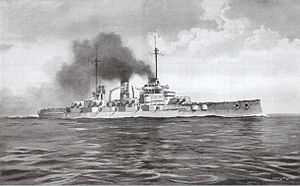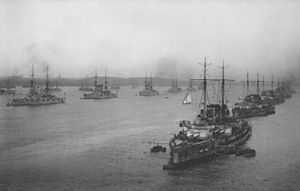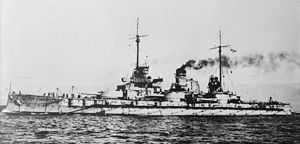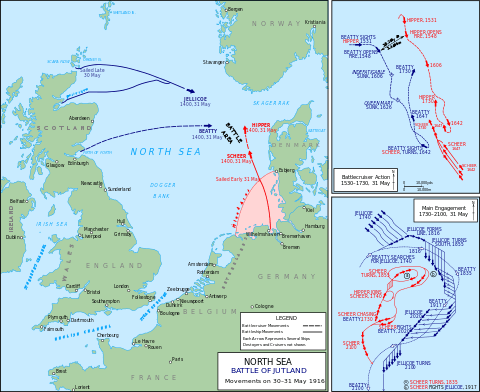SMS Posen
 A recognition drawing of a Nassau-class battleship | |
| Career (German Empire) | |
|---|---|
| Namesake: | Province of Posen[1] |
| Builder: | Germaniawerft, Kiel |
| Laid down: | 11 June 1907 |
| Launched: | 13 December 1908 |
| Commissioned: | 31 May 1910 |
| Fate: | Scrapped 1922 |
| General characteristics | |
| Class and type: | Nassau-class battleship |
| Displacement: |
|
| Length: | 146.1 m (479.3 ft) |
| Beam: | 26.9 m (88.3 ft) |
| Draft: | 8.9 m (29.2 ft) |
| Propulsion: |
|
| Speed: |
|
| Range: | At 12 knots (22 km/h; 14 mph): 8,300 nautical miles (15,370 km; 9,550 mi) |
| Complement: |
|
| Armament: |
|
| Armor: |
|
SMS Posen[lower-alpha 2] was one of four battleships in the Nassau class, the first dreadnoughts built for the German Imperial Navy (Kaiserliche Marine). The ship was laid down at the Germaniawerft shipyard in Kiel on 11 June 1907, launched on 13 December 1908, and commissioned into the High Seas Fleet on 31 May 1910. She was equipped with a main battery of twelve 28 cm (11 in) guns in six twin turrets in an unusual hexagonal arrangement.
The ship served with her three sister ships for the majority of World War I. She saw extensive service in the North Sea, where she took part in several fleet sorties. These culminated in the Battle of Jutland on 31 May – 1 June 1916, where Posen was heavily engaged in night-fighting against British light forces. In the confusion, the ship accidentally rammed the light cruiser SMS Elbing, which suffered serious damage and was scuttled later in the night.
The ship also conducted several deployments to the Baltic Sea against the Russian Navy. In the first of these, Posen supported a German naval assault in the Battle of the Gulf of Riga. The ship was sent back to the Baltic in 1918 to support the White Finns in the Finnish Civil War. At the end of the war, Posen remained in Germany while the majority of the fleet was interned in Scapa Flow. In 1919, following the scuttling of the German fleet in Scapa Flow, she was ceded to the British as a replacement for the ships that had been sunk. She was then sent to ship-breakers in the Netherlands and scrapped in 1922.
Construction
Posen was ordered under the provisional name Ersatz Baden, as a replacement for the Baden, one of the elderly Sachsen-class ironclads.[2] She was laid down on 11 June 1907 at the Germaniawerft shipyard in Kiel.[3] As with her sister Nassau, construction proceeded under absolute secrecy; detachments of soldiers guarded the shipyard and also guarded contractors that supplied building materials, such as Krupp.[4] The ship was launched a year and a half later, on 12 December 1908.[3] Wilhelm August Hans von Waldow-Reitzenstein gave a speech at her launching, and Posen was christened by Johanna von Radolin, the wife of Hugo Fürst von Radolin, a German diplomat who hailed from the ship's namesake province.[5] Initial trials were conducted through April 1910, followed by final fitting-out in May. The ship was commissioned into the fleet on 31 May. Sea trials were conducted afterward and completed by 27 August.[1] In total, her construction cost the German government 36,920,000 marks.[2]
Posen was 146.1 m (479.3 ft) long, 26.9 m (88.3 ft) wide, and had a draft of 8.9 m (29.2 ft). She displaced 18,570 t (18,280 long tons; 20,470 short tons) with a standard load, and 21,000 t (21,000 long tons; 23,000 short tons) fully laden.[lower-alpha 3] The ship had a crew of 40 officers and 968 enlisted men. Posen retained three-shafted triple expansion engines with coal-fired boilers instead of more advanced turbine engines. Her propulsion system was rated at 22,000 indicated horsepower (16,000 kW) and provided a top speed of 20 knots (37 km/h; 23 mph). She had a cruising radius of 8,300 nautical miles (15,400 km; 9,600 mi) at a speed of 12 kn (22 km/h; 14 mph).[2] This type of machinery was chosen at the request of both Admiral Alfred von Tirpitz and the Navy's construction department; the latter stated in 1905 that the "use of turbines in heavy warships does not recommend itself."[6] This decision was based solely on cost: at the time, Parsons held a monopoly on steam turbines and required a 1 million gold mark royalty fee for every turbine engine. German firms were not ready to begin production of turbines on a large scale until 1910.[7]
Posen carried twelve 28 cm (11.0 in) SK L/45[lower-alpha 4] guns in an unusual hexagonal configuration. Her secondary armament consisted of twelve 15 cm (5.9 in) SK L/45 guns and sixteen 8.8 cm (3.5 in) SK L/45 guns, all of which were mounted in casemates.[2] Later in her career, two of the 8.8 cm guns were replaced with high-angle Flak mountings of the same caliber for defense against aircraft.[5] The ship was also armed with six 45 cm (17.7 in) submerged torpedo tubes. One tube was mounted in the bow, another in the stern, and two on each broadside, on either ends of the torpedo bulkhead.[8] The ship's belt armor was 300 mm (11.8 in) thick in the central portion of the hull, and the armored deck was 80 mm (3.1 in) thick. The main battery turrets had 280 mm (11.0 in) thick sides, and the conning tower was protected with 400 mm (15.7 in) of armor plating.[2]
Service history

After completing her trials in August 1910, Posen left Kiel for Wilhelmshaven, where she arrived on 7 September. As the German Imperial Navy had chronic shortages of trained sailors,[9] many of the crew were then assigned to other ships.[1][lower-alpha 5] These crewmembers were replaced with personnel from the old pre-dreadnought Wittelsbach, which was decommissioned on 20 September. After their commissioning, all four Nassau-class ships served as a unit, the II Division of I Battle Squadron, with Posen as the flagship.[1]
Posen participated in several training exercises with the rest of the fleet before the outbreak of war.[1] In late 1910 the fleet conducted a training cruise into the Baltic Sea. The following year the fleet conducted maneuvers in May; the annual summer cruise to Norway followed in July. The fleet participated in another round of fleet exercises in the Baltic in September, followed by another set at the end of the year. The next year followed a similar pattern, though the summer cruise to Norway was interrupted by the Agadir crisis; as a result, the summer cruise only went into the Baltic. The September exercises were conducted off Helgoland in the North Sea; another winter cruise into the Baltic followed at the end of the year.[10] The training schedule returned to normal for 1913 and 1914, and the summer cruises again went to Norway. For the 1914 cruise, the fleet departed for Norwegian waters on 14 July, some two weeks after the assassination of Archduke Franz Ferdinand in Sarajevo. The probability of war cut the cruise short; Posen and the rest of the fleet were back in Wilhelmshaven by 29 July.[11]
World War I
At midnight on 4 August, the United Kingdom declared war on Germany.[12] Posen and the rest of the fleet conducted several advances into the North Sea to support Rear Admiral Franz von Hipper's I Scouting Group battlecruisers.[1] The battlecruisers raided British coastal towns in an attempt to lure out portions of the Grand Fleet where they could be destroyed by the High Seas Fleet.[13] The first such operation was the raid on Scarborough, Hartlepool and Whitby on 15–16 December 1914.[14] On the evening of 15 December, the German battle fleet of 12 dreadnoughts—including Posen and her three sisters—and eight pre-dreadnoughts came to within 10 nmi (19 km; 12 mi) of an isolated squadron of six British battleships. Skirmishes between the rival destroyer screens in the darkness convinced the German fleet commander, Admiral Friedrich von Ingenohl, that he was faced with the Grand Fleet, now deployed in its battle formation. Under orders from Kaiser Wilhelm II to avoid risking the fleet unnecessarily, von Ingenohl broke off the engagement and turned the battlefleet back toward Germany.[15]
Battle of the Gulf of Riga
In August, a special unit from the German fleet attempted to clear the Russian-held Gulf of Riga in order to assist the German Army, which was planning an assault on Riga. To do so, the German planners intended to drive off or destroy the Russian naval forces in the Gulf, which included the pre-dreadnought battleship Slava and some smaller gunboats and destroyers. The German battle fleet was accompanied by several mine-warfare vessels. These ships were tasked with clearing Russian minefields and laying a series of their own minefields in the northern entrance to the gulf, to prevent Russian naval reinforcements from reaching the area. The assembled German flotilla included Posen and her three sister ships, the four Helgoland-class battleships, the battlecruisers Von der Tann, Moltke, and Seydlitz, and several pre-dreadnoughts, operating under the command of von Hipper, now a Vice Admiral. The eight battleships were to provide cover for the forces engaging the Russian flotilla. The first attempt on 8 August was unsuccessful, as it had taken too long to clear the Russian minefields to allow the minelayer Deutschland to lay a minefield of her own.[16]
On 16 August 1915, Posen and Nassau led a second attempt to breach the defenses of the gulf, with Posen as Admiral Schmidt's flagship.[1] The two dreadnoughts were accompanied by 4 light cruisers and 31 torpedo boats. On the first day of the assault the Germans broke through the Russian forces, but two German light craft—the minesweeper T46 and the destroyer V99—were sunk.[17] Posen and Nassau engaged a pair of Russian gunboats, Sivuch and Korietz. Sivuch was sunk that day and Korietz was severely damaged; the ship managed to limp away but had to be scuttled the following day.[1] On the 17th, Posen and Nassau engaged Slava at long range; they scored three hits on the Russian ship and forced her to return to port. By 19 August, the Russian minefields had been cleared and the flotilla entered the Gulf. Reports of Allied submarines in the area prompted the Germans to call off the operation the following day.[18] Admiral Hipper later remarked, "To keep valuable ships for a considerable time in a limited area in which enemy submarines were increasingly active, with the corresponding risk of damage and loss, was to indulge in a gamble out of all proportion to the advantage to be derived from the occupation of the Gulf before the capture of Riga from the land side." In fact, the battlecruiser Moltke had been torpedoed that morning.[19] On 21 August, Schmidt had his flag hauled down from Posen and disbanded the special unit.[1]
Return to the North Sea

By the end of August Posen and the rest of the High Seas Fleet had returned to their anchorages in the North Sea. The next operation conducted was a sweep into the North Sea on 11–12 September, though it ended without any action. Another fleet sortie followed on 23–24 October without encountering any British forces. On 4 March 1916, Posen, Nassau, Westfalen, and Von der Tann steamed out to the Amrumbank to receive the auxiliary cruiser Möwe, which was returning from a raiding mission.[20]
Another uneventful advance into the North Sea took place on 21–22 April. A bombardment mission followed two days later; Posen joined the battleship support for Hipper's battlecruisers while they attacked Yarmouth and Lowestoft on 24–25 April.[20] During this operation, the battlecruiser Seydlitz was damaged by a British mine and had to return to port prematurely. Due to the poor visibility, the operation was soon called off, leaving the British fleet no time to intercept the raiders.[21]
Battle of Jutland

Admiral Reinhard Scheer, who had succeeded Admirals von Ingenohl and Hugo von Pohl as the fleet commander, immediately planned another attack on the British coast. The damage to Seydlitz and condenser trouble on several of the III Battle Squadron dreadnoughts delayed the plan until the end of May.[22] The German battlefleet departed the Jade at 03:30 on 31 May.[23] Posen was assigned to the II Division of the I Battle Squadron as the flagship of Rear Admiral W. Engelhardt. Posen was the first ship in the division, ahead of her three sisters. The II Division was the last unit of dreadnoughts in the fleet; they were followed by only the elderly pre-dreadnoughts of the II Battle Squadron.[24]
Between 17:48 and 17:52, Posen and ten other German battleships engaged the British 2nd Light Cruiser Squadron, though the range and poor visibility prevented effective fire.[25] Shortly thereafter, two British destroyers—Nomad and Nestor—came under intense fire from the German line. Posen fired at Nestor with both her main battery and secondary guns. At 18:35, Nestor exploded and sank under the combined fire of eight battleships.[26] By 20:15, the German fleet had faced the Grand Fleet for a second time and was forced to turn away; in doing so, the order of the German line was reversed. Posen was now the fourth ship in the line, astern of her three sisters.[27]
At around 21:20, Posen and her sister ships were engaged by the battlecruisers of the 3rd Battlecruiser Squadron. Posen was the only ship on the I Battle Squadron to be able to make out a target, which turned out to be the battlecruisers HMS Princess Royal and Indomitable. Posen opened fire at 21:28 at a range of 10,000 m (11,000 yd); she scored one hit on Princess Royal at 21:32 and straddled Indomitable several times, surrounding her with a salvo of shells, before ceasing fire at 21:35.[28]
At about 00:30, the leading units of the German line encountered British destroyers and cruisers. A violent firefight at close range ensued; the leading German battleships, including Posen, opened fire on several British warships. In the confusion, the light cruiser Elbing passed through the German line directly in front of Posen and was rammed. Posen was undamaged, but both of Elbing 's engine rooms were flooded and the ship came to a halt.[29] Two and a half hours later, Elbing spotted several approaching British destroyers, and her captain gave the order to scuttle the ship.[30]
Shortly before 01:00, the German line engaged a flotilla of British destroyers. Posen spotted the destroyers Fortune, Porpoise, and Garland at very close range; she opened fire on the first two ships at ranges between 800 and 1,600 m (870 and 1,750 yd), seriously damaging Porpoise. Fortune quickly sank under fire from Posen and several other battleships, but not before firing two torpedoes which Posen had to evade.[31] At 01:25, Westfalen illuminated the destroyer Ardent and opened fire; Posen joined her shortly thereafter and reported several hits at ranges of 1,000 to 1,200 m (1,100 to 1,300 yd).[32]
Despite the ferocity of the night fighting, the High Seas Fleet punched through the British destroyer forces and reached Horns Reef by 04:00 on 1 June.[33] The German fleet reached Wilhelmshaven a few hours later, where Posen and several other battleships from the I Battle Squadron took up defensive positions in the outer roadstead.[34] Over the course of the battle, the ship had fired fifty-three 28 cm shells, sixty-four 15 cm rounds, and thirty-two 8.8 cm shells.[35] The ship and her crew emerged from the battle completely unscathed by enemy fire.[20]
Beginning in June 1917, Wilhelm von Krosigk served as the ship's commanding officer; he held this position until the end of the war in November 1918.[5]
Expedition to Finland
In February 1918, the German navy decided to send an expedition to Finland to support German army units to be deployed there. The Finns were engaged in a civil war; the White Finns sought a conservative government free from the influence of the newly created Soviet Union, while the Red Guards preferred Soviet-style communism. On 23 February, two of Posen 's sister ships—Westfalen and Rheinland—were assigned as the core of the Sonderverband Ostsee (Special Unit Baltic Sea).[36] The two ships embarked the 14th Jäger Battalion. They departed for the Åland Islands on the following morning. Åland was to be a forward operating base, from which the port of Hanko would be secured. From Hanko, the German expedition would assault the capital of Helsingfors. The task force reached the Åland Islands on 5 March, where they encountered the Swedish coastal defense ships HSwMS Sverige, Thor, and Oscar II. Negotiations ensued, which resulted in the landing of the German troops on Åland on 7 March; Westfalen then returned to Danzig, where Posen was stationed.[37]
On 31 March Posen and Westfalen left Danzig; the ships arrived at Russarö, which was the outer defense for Hanko, by 3 April. The German army quickly took the port. The task force then proceeded to Helsingfors; on 11 April the ship passed into the harbor at Helsingfors and landed the soldiers. This included a detachment from the ship which was landed two days later on 13 April. During the operation, Posen 's crew suffered four men killed and twelve wounded. From 18 to 20 April, Posen assisted with the efforts to free Rheinland, which had been grounded. Two days later, Posen struck a sunken wreck in Helsingfors harbor, which caused minor damage. On 30 April the ship was detached from the Sonderverband Ostsee. The ship returned to Germany, reaching Kiel by 3 May, where she entered drydock. Repair work lasted until 5 May.[20]
Later actions in the North Sea
On 11 August 1918, Posen, Westfalen, Kaiser, and Kaiserin sortied from Wilhelmshaven to support torpedo boats on patrol off Terschelling.[37] On 2 October, Posen moved out into the outer roadsteads of the Jade to provide cover for the returning U-boats of the Flanders Flotilla. Posen was to have taken part in the last fleet operation of the war,[20] planned for 30 October. The operation was intended to inflict as much damage as possible on the British navy, in order to retain a better bargaining position for Germany, whatever the cost to the fleet. War-weary sailors mutinied, which led to the operation being canceled. In an attempt to suppress the spread of mutinous sentiments, Admiral Hipper ordered the fleet dispersed.[38] Posen and the other ships of the I Battle Squadron were sent out into the roadstead on 3 November, then returned to Wilhelmshaven on 6 November.[20]
Fate
On 11 November 1918, the Armistice took effect; according to its terms, eleven battleships and five battlecruisers were to be interned in Scapa Flow for the duration of negotiations for the peace treaty.[39] Posen was not among the ships interned, and she was instead decommissioned on 16 December. The ships in Scapa Flow were scuttled by their crews on 21 June 1919 to prevent them from being seized by the Allies. As a result, Posen and the other battleships that remained in Germany were seized as replacements for the ships that had been lost. On 5 November, Posen was stricken from the German navy list to be handed over to Great Britain. The ship was transferred on 13 May 1920; the British subsequently sold her to ship-breakers in the Netherlands.[20] Posen was broken up in Dordrecht in 1922.[40]
Notes
Footnotes
- ↑ Each eight-ship battle squadron had a flagship that also functioned as the flagship of the first four-ship division; a second command flagship served as the leader of the second division in each squadron. At the Battle of Jutland, Posen served as the second command flagship, flying the flag of Rear Admiral Walter Engelhardt. See: Tarrant, p. 286
- ↑ "SMS" stands for "Seiner Majestät Schiff", or "His Majesty's Ship".
- ↑ According to Erich Gröner, this figure is calculated as "25 to 50 percent full load...and [was] used in the German navy since 1882 as a basis for performance and speed calculations." See: Gröner, p. ix
- ↑ In Imperial German Navy gun nomenclature, "SK" (Schnelladekanone) denotes that the gun is quick firing, while "L/45" provides the length of the gun in terms of the diameter of the barrel. In this case, the L/45 gun is 45 calibers, which means that the gun is 45 times as long as its diameter. See: Grießmer, p. 177.
- ↑ Of the problem, Admiral Oldekop stated in November 1912: "There is almost no more personnel on land. Garrison watch duty can no longer be conducted according to regulations...The Navy units [in Kiel] are equally exhausted as in Wilhelmshaven. Complaints concerning lack of personnel on land are the same." See: Herwig, p. 90.
Citations
- ↑ 1.0 1.1 1.2 1.3 1.4 1.5 1.6 1.7 1.8 Staff, p. 32.
- ↑ 2.0 2.1 2.2 2.3 2.4 Gröner, p. 23.
- ↑ 3.0 3.1 Staff, p. 20.
- ↑ Hough, p. 26.
- ↑ 5.0 5.1 5.2 Hildebrand Röhr & Steinmetz, p. 239.
- ↑ Herwig, pp. 59–60.
- ↑ Staff, pp. 23, 35.
- ↑ Gardiner & Gray, p. 140.
- ↑ Herwig, p. 90.
- ↑ Staff, p. 8.
- ↑ Staff, p. 11.
- ↑ Herwig, p. 144.
- ↑ Herwig, pp. 149–150.
- ↑ Tarrant, p. 31.
- ↑ Tarrant, pp. 31–33.
- ↑ Halpern, pp. 196–197.
- ↑ Halpern, p. 197.
- ↑ Halpern, pp. 197–198.
- ↑ Halpern, p. 198.
- ↑ 20.0 20.1 20.2 20.3 20.4 20.5 20.6 Staff, p. 33.
- ↑ Tarrant, pp. 52–54.
- ↑ Tarrant, pp. 56–58.
- ↑ Tarrant, p. 62.
- ↑ Tarrant, p. 286.
- ↑ Campbell, p. 54.
- ↑ Campbell, p. 101.
- ↑ Tarrant, p. 172.
- ↑ Campbell, p. 254.
- ↑ Campbell, p. 286.
- ↑ Campbell, p. 295.
- ↑ Campbell, p. 289.
- ↑ Campbell, p. 290.
- ↑ Tarrant, pp. 246–247.
- ↑ Tarrant, p. 263.
- ↑ Tarrant, p. 292.
- ↑ Ganz, pp. 85–86.
- ↑ 37.0 37.1 Staff, p. 27.
- ↑ Tarrant, pp. 280–281.
- ↑ Gardiner & Gray, p. 139.
- ↑ Gröner, p. 24.
References
- Campbell, John (1998). Jutland: An Analysis of the Fighting. London: Conway Maritime Press. ISBN 978-1-55821-759-1.
- Ganz, A. Harding (April 1980). "The German Expedition to Finland, 1918". Military Affairs (Lexington, VA: Society for Military History) 44 (2): 84–91. doi:10.2307/1986604. JSTOR 1986604.
- Gardiner, Robert; Gray, Randal, eds. (1985). Conway's All the World's Fighting Ships: 1906–1921. Annapolis: Naval Institute Press. ISBN 978-0-87021-907-8.
- Grießmer, Axel (1999). Die Linienschiffe der Kaiserlichen Marine (in German). Bonn: Bernard & Graefe Verlag. ISBN 978-3-7637-5985-9.
- Gröner, Erich (1990). German Warships: 1815–1945. Annapolis: Naval Institute Press. ISBN 978-0-87021-790-6. OCLC 22101769.
- Halpern, Paul G. (1995). A Naval History of World War I. Annapolis: Naval Institute Press. ISBN 978-1-55750-352-7. OCLC 57447525.
- Herwig, Holger (1998) [1980]. "Luxury" Fleet: The Imperial German Navy 1888–1918. Amherst, New York: Humanity Books. ISBN 978-1-57392-286-9. OCLC 57239454.
- Hildebrand, Hans H.; Röhr, Albert; Steinmetz, Hans-Otto (1993). Die Deutschen Kriegsschiffe 6. Ratingen: Mundus Verlag. ASIN B003VHSRKE. ISBN 978-3-8364-9743-5.
- Hough, Richard (2003). Dreadnought: A History of the Modern Battleship. Penzance, Cornwall, UK: Periscope Publishing. ISBN 978-1-904381-11-2.
- Staff, Gary (2010). German Battleships: 1914–1918 1. Oxford: Osprey Books. ISBN 978-1-84603-467-1. OCLC 705750106.
- Tarrant, V. E. (2001) [1995]. Jutland: The German Perspective. London: Cassell Military Paperbacks. ISBN 978-0-304-35848-9. OCLC 48131785.
| ||||||||||||||